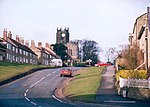St Michael's Church, Coxwold

St Michael's Church is an Anglican parish church in Coxwold, North Yorkshire, England. The Parish of Coxwold is part of the Church of England's Diocese of York.The earliest church on the site dates to the Anglo-Saxon period. That church was replaced by a Norman one built in the 11th century, and that in turn was replaced with the present church which was built by 1430. The church is in the Perpendicular style, and among its unusual features are an octagonal tower and a tongue-shaped altar rail. The church is a grade I listed building.The church is the resting place of Rear Admiral Lord Adolphus FitzClarence, an illegitimate son of Prince William, the future William IV, and his mistress Dorothea Jordan.
Excerpt from the Wikipedia article St Michael's Church, Coxwold (License: CC BY-SA 3.0, Authors, Images).St Michael's Church, Coxwold
Husthwaite Road,
Geographical coordinates (GPS) Address Nearby Places Show on map
Geographical coordinates (GPS)
| Latitude | Longitude |
|---|---|
| N 54.18786 ° | E -1.1847 ° |
Address
Husthwaite Road
YO61 4AE , Coxwold
England, United Kingdom
Open on Google Maps










